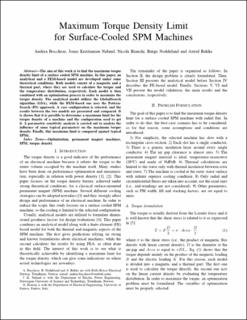| dc.contributor.author | Bocchese, Andrea | |
| dc.contributor.author | Nøland, Jonas Kristiansen | |
| dc.contributor.author | Bianchi, Nicola | |
| dc.contributor.author | Noddeland, Børge | |
| dc.contributor.author | Røkke, Astrid | |
| dc.date.accessioned | 2021-02-01T10:36:54Z | |
| dc.date.available | 2021-02-01T10:36:54Z | |
| dc.date.created | 2020-12-02T14:20:02Z | |
| dc.date.issued | 2020 | |
| dc.identifier.isbn | 978-1-7281-9945-0 | |
| dc.identifier.uri | https://hdl.handle.net/11250/2725525 | |
| dc.description.abstract | The aim of this work is to find the maximum torque density limit of a surface cooled SPM machine. In this paper, an analytical and a FEM-based model are developed under some theoretical conditions. Both models consist of a magnetic and a thermal part, where they are used to calculate the torque and the temperature distribution, respectively. Each model is then combined with an optimization process in order to maximize the torque density. The analytical model utilizes the GlobalSearch algorithm (GSA), while the FEM-based one uses the Pattern-Search (PS) approach. A case configuration is selected, and the results between the two models are presented and compared. It is shown that it is possible to determine a maximum limit for the torque density of a machine and the configuration used to get it. A parametric sensitivity analysis is carried out to analyze the influence of some typical parameters on the maximum torque density. Finally, this maximum limit is compared against typical SPMs. | en_US |
| dc.language.iso | eng | en_US |
| dc.publisher | Institute of Electrical and Electronics Engineers (IEEE) | en_US |
| dc.relation.ispartof | Proc. 2020 International Conference on Electrical Machines (ICEM) | |
| dc.relation.uri | https://ieeexplore.ieee.org/document/9270815 | |
| dc.title | Maximum Torque Density Limit for Surface-Cooled SPM Machines | en_US |
| dc.type | Chapter | en_US |
| dc.description.version | acceptedVersion | en_US |
| dc.source.pagenumber | 218-224 | en_US |
| dc.identifier.doi | 10.1109/ICEM49940.2020.9270815 | |
| dc.identifier.cristin | 1855389 | |
| dc.description.localcode | © 2020 IEEE. Personal use of this material is permitted. Permission from IEEE must be obtained for all other uses, in any current or future media, including reprinting/republishing this material for advertising or promotional purposes, creating new collective works, for resale or redistribution to servers or lists, or reuse of any copyrighted component of this work in other works. | en_US |
| cristin.ispublished | true | |
| cristin.fulltext | postprint | |
| cristin.qualitycode | 1 | |
